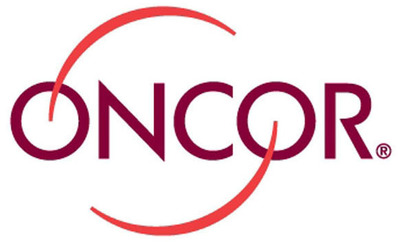ONCOR REPORTS 2023 RESULTS; ANNOUNCES $24.2 BILLION 2024-2028 CAPITAL PLAN
"
"As we reflect on our performance in the fourth quarter, and throughout 2023, it's clear that we're on an extraordinary and diverse growth path across our service area. This growth is driving our largest-ever capital plan, which will expand our investments in the ERCOT market and also help make our service more reliable, helping to better serve both new and existing customers," said Oncor CEO Allen Nye. "We also expect our first system resiliency plan filing later this year will lay out additional strategic investments in system hardening and modernization, enhanced vegetation management, wildfire mitigation, new technology and other resiliency measures over a three-year period. This will help us deliver a safer, smarter and more resilient electric grid for our state. As
Oncor's reported net income of
Oncor's total distribution base revenues in the twelve months ended December 31, 2023 as compared to the twelve months ended December 31, 2022 increased
Growth Within Oncor's Service Territory
Oncor experienced another strong year in 2023 with solid growth in premises and the construction of new transmission and distribution lines, as well as the setting of new year-end company records for transmission point-of-interconnection ("POI") requests, all while remaining focused on safety and reliability.
Ongoing growth within
In 2023, Oncor set company records for annual active and new generation and retail transmission POI requests in queue. At December 31, 2023, Oncor had 763 active generation and retail transmission POI requests in queue, representing a
Oncor's service territory continues to be vibrant, diverse and growing and has seen significant growth in commercial and industrial customers representing electric loads that are substantially larger than traditional commercial projects. Data center development continues to be robust across the Oncor service territory, including new sites that have the potential to support hyperscale computing and generative artificial intelligence services. These projects represent the potential for hundreds of megawatts of new electric load.
Capital Plan Update
Capital expenditures totaled approximately
The increase in Oncor's five-year capital plan compared to its prior five-year capital plan is due primarily to continued projected growth and expansion of its system, particularly on the transmission side of Oncor's business as a result of the large volume of customer interconnection requests and generator interconnection requests that it has received through 2023 and expects to continue to receive. The increase is also partially driven by higher material costs due to tightening supply chains as well as increases in labor and contractor costs. In addition, Oncor anticipates that significant potential capital investment opportunities incremental to its five-year capital plan may be available as a result of continued growth in ERCOT, particularly on the transmission side of its business due to increased customer demand and additional distribution-related reliability and resiliency needs.
Operational Highlights
Oncor's employees helped to ensure Texans had reliable power in 2023 as the state experienced significantly higher than normal summer temperatures in 2023. The ERCOT market saw 10 new peak demand records and reached a new all-time record peak demand of 85,508 megawatts on August 10, 2023, reflecting a
Duration Index (non-storm), Oncor's customers experienced on average five fewer minutes of outage in 2023 compared to 2022 – an improvement of approximately
In the fourth quarter of 2023, Oncor completed its annual review of its wildfire mitigation plan, which contains focused initiatives in areas such as asset management, operational protocols, vegetation management, system protection technology and stakeholder engagement. Oncor's wildfire mitigation strategy also includes a risk modeling tool, through which various risk factors are analyzed to inform long-term initiatives and real-time operational protocols, such as identification of wildfire mitigation zones. Oncor anticipates building on these efforts through new investments in wildfire mitigation in its inaugural SRP.
Oncor continued to be active in sustainability matters in 2023. In May, Oncor published its green bond spend report relating to its inaugural green bond issuance. In October, an independent third party environmental, social and governance ("ESG") ratings company issued its annual ESG risk rating of Oncor, improving Oncor's rating and ranking Oncor in the top 2 percent of electric utilities rated by that company at that time, reflecting lower ESG risk. Also, in 2023, Oncor was named as a 2023 Best Places to Work for Disability Inclusion by Disability:IN.
Liquidity
As of February 26, 2024, Oncor's available liquidity, consisting of cash on hand and available borrowing capacity under its existing credit facilities, commercial paper program and accounts receivable facility ("AR Facility"), totaled
Sempra Internet Broadcast Today
Sempra (NYSE: SRE) (BMV: SRE) will broadcast a live discussion of its earnings results over the Internet today at 12 p.m. ET, which will include discussion of 2023 results and other information relating to Oncor. Oncor Chief Executive Allen Nye will also participate in the broadcast. Access to the broadcast is available by logging onto the Investors section of Sempra's website, sempra.com/investors. Prior to the conference call, an accompanying slide presentation will be posted on sempra.com/investors. For those unable to participate in the live webcast, it will be available on replay a few hours after its conclusion at sempra.com/investors.
Annual Report on Form 10-K
Oncor's Annual Report on Form 10-K for the year ended December 31, 2023 will be filed with the
Oncor Electric Delivery Company LLC | ||||||||||||
Table A – Statements of Consolidated Net Income | ||||||||||||
Three and Twelve Months Ended December 31, 2023 and 2022; $ millions | ||||||||||||
Q4 '23 | Q4 '22 | TME '23 | TME '22 | |||||||||
Operating revenues | $ 1,359 | $ 1,263 | $ 5,586 | $ | 5,243 | |||||||
Operating expenses: | ||||||||||||
Wholesale transmission service | 326 | 300 | 1,291 | 1,162 | ||||||||
Operation and maintenance | 320 | 287 | 1,150 | 1,055 | ||||||||
Depreciation and amortization | 249 | 232 | 978 | 904 | ||||||||
Provision in lieu of income taxes | 39 | 39 | 185 | 201 | ||||||||
Taxes other than amounts related to income taxes | 124 | 129 | 552 | 561 | ||||||||
Write-off of rate base disallowances | - | - | 55 | - | ||||||||
Total operating expenses | 1,058 | 987 | 4,211 | 3,883 | ||||||||
Operating income | 301 | 276 | 1,375 | 1,360 | ||||||||
Other (income) and deductions – net | (21) | 1 | (31) | 20 | ||||||||
Non-operating provision (benefit) in lieu of income taxes | 1 | (3) | (8) | (10) | ||||||||
Interest expense and related charges | 140 | 114 | 536 | 445 | ||||||||
Write-off of non-operating rate base disallowances | - | - | 14 | - | ||||||||
Net income | $ | 181 | $ | 164 | $ | 864 | $ | 905 | ||||
Oncor Electric Delivery Company LLC | ||||||
Table B – Statements of Consolidated Cash Flows | ||||||
Twelve Months Ended December 31, 2023 and 2022; $ millions | ||||||
TME '23 | TME '22 | |||||
Cash flows — operating activities: | ||||||
Net income | $ | 864 | $ | 905 | ||
Adjustments to reconcile net income to cash provided by operating activities: | ||||||
Depreciation and amortization, including regulatory amortization | 1,117 | 985 | ||||
Write-off of rate base disallowances | 69 | - | ||||
Provision in lieu of deferred income taxes – net | 61 | 41 | ||||
Other – net | (10) | (14) | ||||
Changes in operating assets and liabilities: | ||||||
Accounts receivable | (43) | (138) | ||||
Inventories | (137) | (32) | ||||
Accounts payable – trade | 42 | 45 | ||||
Regulatory assets – deferred revenues | 1 | 120 | ||||
Regulatory assets – self-insurance reserve | (232) | (198) | ||||
Other – assets | (22) | 16 | ||||
Other – liabilities | 90 | 137 | ||||
Cash provided by operating activities | 1,800 | 1,867 | ||||
Cash flows — financing activities: | ||||||
Issuances and borrowings of long-term debt (excluding AR Facility) | 2,975 | 3,950 | ||||
Repayments of long-term debt (excluding AR Facility) | (875) | (2,732) | ||||
Borrowings under AR Facility | 600 | - | ||||
Repayments under AR Facility | (600) | - | ||||
Net change in short-term borrowings | 84 | (17) | ||||
Capital contributions from members | 452 | 425 | ||||
Distributions to members | (552) | (425) | ||||
Debt discount, financing and reacquisition costs – net | (46) | (31) | ||||
Cash provided by financing activities | 2,038 | 1,170 | ||||
Cash flows — investing activities: | ||||||
Capital expenditures | (3,824) | (3,049) | ||||
Expenditures for third party in joint project | - | (2) | ||||
Reimbursement from third party in joint project | 1 | 6 | ||||
Proceeds from sales of non-utility properties | 9 | 21 | ||||
Other – net | 29 | 31 | ||||
Cash used in investing activities | (3,785) | (2,993) | ||||
Net change in cash, cash equivalents and restricted cash | 53 | 44 | ||||
Cash, cash equivalents and restricted cash — beginning balance | 98 | 54 | ||||
Cash, cash equivalents and restricted cash — ending balance | $ | 151 | $ | 98 | ||
Oncor Electric Delivery Company LLC | ||||||
Table C – Consolidated Balance Sheets | ||||||
At December 31, 2023 and 2022; $ millions | ||||||
At 12/31/23 | At 12/31/22 | |||||
ASSETS | ||||||
Current assets: | ||||||
Cash and cash equivalents | $ 19 | $ 10 | ||||
Restricted cash, current | 24 | 16 | ||||
Accounts receivable – net | 944 | 884 | ||||
Amounts receivable from members related to income taxes | 4 | - | ||||
Materials and supplies inventories — at average cost | 341 | 204 | ||||
Prepayments and other current assets | 101 | 109 | ||||
Total current assets | 1,433 | 1,223 | ||||
Restricted cash, noncurrent | 108 | 72 | ||||
Investments and other property | 158 | 137 | ||||
Property, plant and equipment – net | 28,057 | 25,203 | ||||
Goodwill | 4,740 | 4,740 | ||||
Regulatory assets | 1,556 | 1,502 | ||||
Right-of-use operating lease and other assets | 142 | 161 | ||||
Total assets | $ 36,194 | $ 33,038 | ||||
LIABILITIES AND MEMBERSHIP INTERESTS | ||||||
Current liabilities: | ||||||
Short-term borrowings | $ 282 | $ 198 | ||||
Long-term debt, current | - | 100 | ||||
Accounts payable – trade | 600 | 536 | ||||
Amounts payable to members related to income taxes | 27 | 45 | ||||
Accrued taxes other than amounts related to income | 261 | 277 | ||||
Accrued interest | 117 | 97 | ||||
Operating lease and other current liabilities | 338 | 330 | ||||
Total current liabilities | 1,625 | 1,583 | ||||
Long-term debt, noncurrent | 13,294 | 11,128 | ||||
Liability in lieu of deferred income taxes | 2,320 | 2,182 | ||||
Regulatory liabilities | 3,000 | 3,014 | ||||
Employee benefit plan obligations | 1,442 | 1,394 | ||||
Operating lease and other obligations | 305 | 275 | ||||
Total liabilities | 21,986 | 19,576 | ||||
Commitments and contingencies | ||||||
Membership interests: | ||||||
Capital account ― number of units outstanding 2023 and 2022 – 635,000,000 | 14,388 | 13,624 | ||||
Accumulated other comprehensive loss | (180) | (162) | ||||
Total membership interests | 14,208 | 13,462 | ||||
Total liabilities and membership interests | $ 36,194 | $ 33,038 | ||||
Oncor Electric Delivery Company LLC | ||||||||||||
Table D – Operating Statistics | ||||||||||||
Three and Twelve Months Ended December 31, 2023 and 2022; mixed measures | ||||||||||||
Q4 '23 | Q4 '22 | TME '23 | TME '22 | |||||||||
Operating statistics: | ||||||||||||
Electric energy volumes (gigawatt-hours): | ||||||||||||
Residential | 9,146 | 10,054 | 47,112 | 49,648 | ||||||||
Commercial, industrial, small business and other | 26,760 | 23,626 | 109,365 | 99,612 | ||||||||
Total electric energy volumes | 35,906 | 33,680 | 156,477 | 149,260 | ||||||||
Operating revenues ($ millions): | ||||||||||||
Revenues contributing to earnings: | ||||||||||||
Distribution base revenues (a) | $ 622 | $ 559 | $ 2,628 | $ 2,447 | ||||||||
Transmission base revenues (TCOS revenues) | ||||||||||||
Billed to third-party wholesale customers | 238 | 237 | 959 | 944 | ||||||||
Billed to REPs serving Oncor distribution customers, through TCRF | 134 | 134 | 539 | 528 | ||||||||
Total transmission base revenues | 372 | 371 | 1,498 | 1,472 | ||||||||
Other miscellaneous revenues | 26 | 23 | 109 | 112 | ||||||||
Total revenues contributing to earnings | 1,020 | 953 | 4,235 | 4,031 | ||||||||
Revenues collected for pass-through expenses: | ||||||||||||
TCRF – third-party wholesale transmission service | 326 | 300 | 1,291 | 1,162 | ||||||||
EECRF and other revenues | 13 | 10 | 60 | 50 | ||||||||
Total revenues collected for pass-through expenses | 339 | 310 | 1,351 | 1,212 | ||||||||
Total operating revenues | $ 1,359 | $ 1,263 | $ 5,586 | $ 5,243 | ||||||||
Residential system weighted weather data (b): | ||||||||||||
Cooling degree days | 113 | 92 | 2,268 | 2,204 | ||||||||
Heating degree days | 222 | 360 | 608 | 971 | ||||||||
Reliability statistics (c): | TME '23 | TME '22 | ||||||||||
System Average Interruption Duration Index (SAIDI) (non-storm) | 70.0 | 75.0 | ||||||||||
System Average Interruption Frequency Index (SAIFI) (non-storm) | 1.0 | 1.2 | ||||||||||
Customer Average Interruption Duration Index (CAIDI) (non-storm) | 70.7 | 63.5 | ||||||||||
Electricity distribution points of delivery (based on number of active meters) ― end of period and in thousands | 3,969 | 3,896 | ||||||||||
_____________ | |
(a) | In general, distribution revenues from residential and small business users are based on actual monthly consumption (kWh), and, depending on size and annual load factor, revenues from large commercial and industrial users are based either on actual monthly demand (kilowatts) or the greater of actual monthly demand (kilowatts) or |
(b) | Degree days are measures of how warm or cold it is throughout Oncor's service territory. A degree day compares the average of the hourly outdoor temperatures during each day to a 65° Fahrenheit standard temperature. The more extreme the outside temperature, the higher the number of degree days. A high number of degree days generally results in higher levels of energy use for space cooling or heating. |
(c) | SAIDI is the average number of minutes electric service is interrupted per consumer in a twelve-month period. SAIFI is the average number of electric service interruptions per consumer in a twelve-month period. CAIDI is the average duration in minutes per electric service interruption in a twelve- month period. In each case, Oncor's non-storm reliability performance reflects electric service interruptions of one minute or more per customer. Each of these results excludes outages during significant storm events. |
Headquartered in
Forward-Looking Statements
This news release contains forward-looking statements relating to Oncor within the meaning of the Private Securities Litigation Reform Act of 1995, which are subject to risks and uncertainties. All statements, other than statements of historical facts, that are included in this news release, as well as statements made in presentations, in response to questions or otherwise, that address activities, events or developments that Oncor expects or anticipates to occur in the future, including such matters as projections, capital allocation, future capital expenditures, business strategy, competitive strengths, goals, future acquisitions or dispositions, development or operation of facilities, market and industry developments and the growth of Oncor's business and operations (often, but not always, through the use of words or phrases such as "intends," "plans," "will likely result," "are expected to," "will continue," "is anticipated," "estimated," "forecast," "should," "projection," "target," "goal," "objective" and "outlook"), are forward-looking statements. Although Oncor believes that in making any such forward-looking statement its expectations are based on reasonable assumptions, any such forward-looking statement involves risks, uncertainties and assumptions. Factors that could cause Oncor's actual results to differ materially from those projected in such forward-looking statements include: legislation, governmental policies and orders, and regulatory actions; legal and administrative proceedings and settlements, including the exercise of equitable powers by courts; weather conditions and other natural phenomena, including any weather impacts due to climate change; acts of sabotage, wars, terrorist activities, cybersecurity attacks, wildfires, fires, explosions, hazards customary to the industry, or other emergency events and the possibility that Oncor may not have adequate insurance to cover losses or third-party liabilities related to any such event; actions by credit rating agencies; health epidemics and pandemics, including their impact on Oncor's business and the economy in general; interrupted or degraded service on key technology platforms, facilities failures, or equipment interruptions; economic conditions, including the impact of a recessionary environment, inflation, supply chain disruptions, competition for goods and services, service provider availability, and labor availability and cost; unanticipated population growth or decline, or changes in market demand and demographic patterns, particularly in the ERCOT region; ERCOT grid needs and ERCOT market conditions, including insufficient electric capacity within ERCOT or disruptions at power generation facilities that supply power within ERCOT; changes in business strategy, development plans or vendor relationships; changes in interest rates or rates of inflation; significant changes in operating expenses, liquidity needs and/or capital expenditures; inability of various counterparties to meet their financial and other obligations to Oncor, including failure of counterparties to timely perform under agreements; general industry and ERCOT trends; significant decreases in demand or consumption of electricity delivered by Oncor, including as a result of increased consumer use of third-party distributed energy resources or other technologies; changes in technology used by and services offered by Oncor; significant changes in Oncor's relationship with its employees, including the availability of qualified personnel, and the potential adverse effects if labor disputes or grievances were to occur; changes in assumptions used to estimate costs of providing employee benefits, including pension and retiree benefits, and future funding requirements related thereto; significant changes in accounting policies or critical accounting estimates material to Oncor; commercial bank and financial market conditions, macroeconomic conditions, access to capital, the cost of such capital, and the results of financing and refinancing efforts, including availability of funds and the potential impact of any disruptions in
Further discussion of risks and uncertainties that could cause actual results to differ materially from management's current projections, forecasts, estimates and expectations is contained in filings made by Oncor with the
![]() View original content to download multimedia:https://www.prnewswire.com/news-releases/oncor-reports-2023-results-announces-24-2-billion-2024-2028-capital-plan-302072217.html
View original content to download multimedia:https://www.prnewswire.com/news-releases/oncor-reports-2023-results-announces-24-2-billion-2024-2028-capital-plan-302072217.html
SOURCE Oncor Electric Delivery Company LLC








